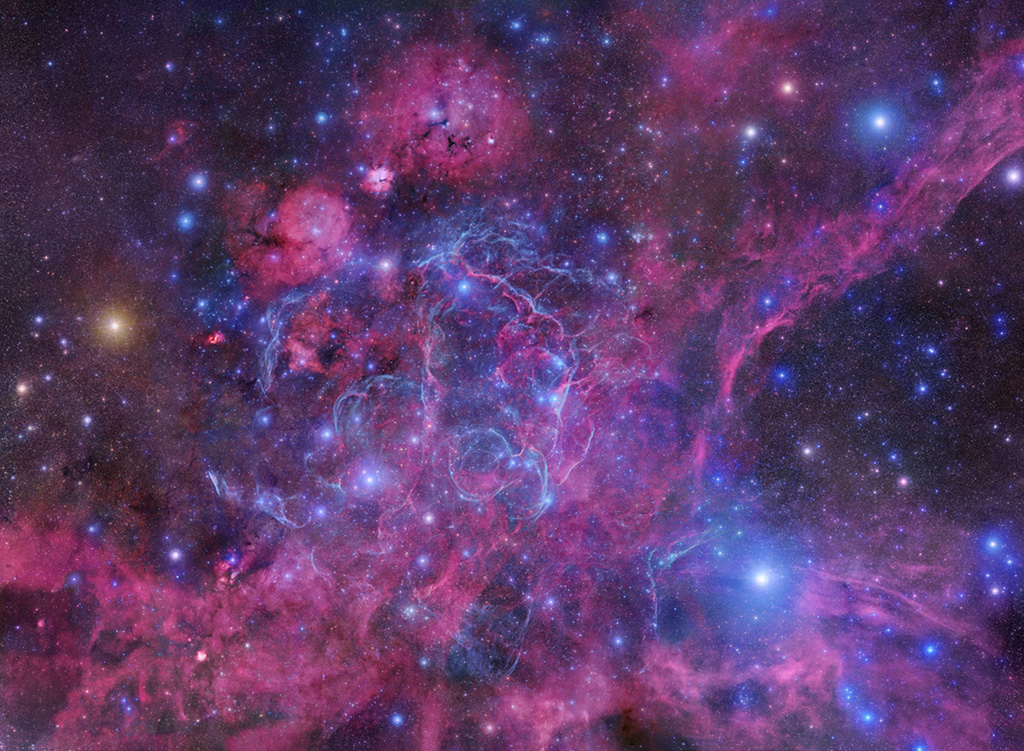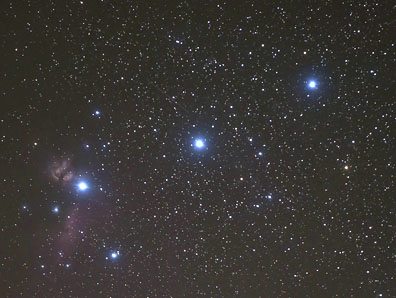BDanielMayfield wrote: ↑Sat Sep 19, 2020 4:27 am
Yesterday,
Ann wrote:I think today's APOD has been replaced. Yesterday's APOD said that tomorrow's APOD (that is, today's APOD of September 18) would be Orion in 3D. I groaned, because I just can't deal with 3D pictures.
I kinda agreed, I don't much care for them either. But this isn't what we thought it might be, is it. Actually, I quite like this presentation of Orion. This is very informative.
Thanks for including this as an APOD.
I really like it too!

Except I don't believe in it!

Take a look at the picture at right of the Vela Supernova remnant. There are two bright blue stars there, Gamma Velorum at bottom right and Zeta Puppis at upper right. Gamma Velorum is noticeably brighter than Zeta Puppis.
These two stars are far away. When the Hipparcos satellite measured their parallaxes, their apparent "back and forth movement" across the sky as the Earth orbits the Sun, the measured parallaxes were so small that they were within the margin of error.
Anyway. The person analysing the Hipparcos data first thought that the parallax of Zeta Puppis was particularly small, and that Zeta Puppis was considerably farther away than Gamma Velorum. Because the truth is that a parallax of 1 milliarcsecond makes a huge difference in distance compared with a parallax of 2 milliarcseconds - but they are both completely within the margin of error.
Anyway, Zeta Puppis and Gamma Velorum. In 2008, Jim Kaler took the miniscule Hipparcos parallax of Zeta Puppis at face value and wrote the following:
Jim Kaler wrote about Zeta Puppis:
Its large distance of 1400 light years shows it to be visually 22,000 times more luminous than the Sun. Its high temperature of 42,000 Kelvin, however, causes most of the star's radiation to be emitted in the invisible ultraviolet, and when that is taken into account, the total luminosity comes in at three-quarters of a million times solar.
But the Hipparcos parallax of Zeta Puppis has since been revised. It is now deemed to just a little larger. And lo and behold, suddenly the distance to Zeta Puppis shrinks to 1084 ± 36 light-years (according to my Guide) and its visual luminosity drops by almost half, to 11990 ± 800 Solar.
The distance to Gamma Velorum hasn't been revised downwards, because its parallax hasn't been deemed to be larger than first assumed. So now Gamma Velorum is thought to be marginally farther away from us than Zeta Puppis.
My point? Consider the parallaxes of the stars of Orion's Belt. The Hipparcos parallax of Alnitak is 4.43 ± 0.64 milliarcseconds. The Hipparcos parallax for Alnilam is 1.65 ± 0.45 mas, and the Hipparcos parallax for Mintaka is 4.71 ± 0.58 mas.
These parallaxes would put Alnilam, the middle star of Orion's Belt, more than twice as far away from us as the two other Belt stars.
Here's the deal. You can't trust those parallaxes. They are way too small to be reliable. Heck, Hipparcos isn't thought to have done a very good job at measuring
the distance to the Pleiades, whose distance has long been thought to be around 440 light-years, much more nearby than Alnilam, Alnitak and Mintaka. Hipparcos put them at only about 400 light-years, or some 120 parsecs. The consensus is that the Hipparcos distance estimate for the Pleiades is wrong.
So today's APOD is fun, and I really appreciate it! But I must warn you: It shows you the distances of the stars of Orion as inferred from the parallaxes measured by Hipparcos, and they may very well be a far cry from reality.
So if Alnilam turns out to be at more or less the same distance from us as Alnitak and Mintaka, you shouldn't be surprised.
Ann
 Orion in Depth
Orion in Depth
